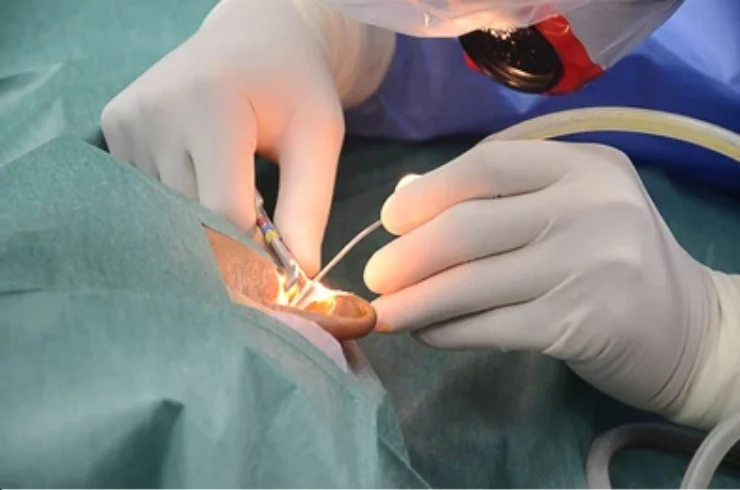Endoscopic and Microscopic Ear Surgeries

Endoscopic and Microscopic Ear Surgeries are specialized techniques used to treat various ear conditions, offering precise, minimally invasive solutions to improve hearing and overall ear health. These advanced methods allow surgeons to visualize and treat inner ear problems with greater accuracy, reducing recovery times and enhancing patient outcomes.
Endoscopic Ear Surgery
Endoscopic ear surgery uses a small, flexible tube with a camera (endoscope) to visualize the structures of the ear, allowing the surgeon to perform procedures with minimal incisions. This technique has become increasingly popular due to its precision and ability to provide excellent visibility of the ear’s inner structures, particularly in complex or narrow areas.
Common Conditions Treated with Endoscopic Ear Surgery:
- Chronic Otitis Media: Long-term ear infections leading to damage of the middle ear.
- Tympanic Membrane Perforations: Holes in the eardrum that affect hearing and increase the risk of infections.
- Cholesteatoma: Abnormal skin growth in the middle ear that can lead to hearing loss, dizziness, or infection.
- Mastoiditis: Inflammation of the mastoid bone, often due to untreated ear infections.
Advantages of Endoscopic Ear Surgery:
- Minimally Invasive: Small incisions with no external scars, which reduces the risk of infection and minimizes recovery time.
- Enhanced Visualization: The endoscope provides a clear and detailed view of the ear structures, allowing for more accurate treatment.
- Faster Recovery: Shorter healing time compared to traditional ear surgeries, with most patients returning to normal activities within days.
Procedure Overview:
- Anesthesia: The patient is usually given local anesthesia, although general anesthesia may be used depending on the complexity of the surgery.
- Insertion of Endoscope: The surgeon inserts the endoscope through the ear canal to gain a clear view of the affected area.
- Surgical Intervention: Using specialized instruments, the surgeon can remove or repair damaged tissue, such as the eardrum or bone structures, without making large incisions.
- Closure: In many cases, no external stitches are required, and the ear canal is left to heal naturally.
Microscopic Ear Surgery
Microscopic ear surgery uses a high-powered surgical microscope, which offers detailed, magnified views of the inner ear and surrounding structures. This technique is particularly useful for complex ear conditions requiring precise manipulation of tiny structures like the ossicles (small bones of the middle ear), cochlea, and eardrum.
Common Conditions Treated with Microscopic Ear Surgery:
- Otosclerosis: Abnormal bone growth in the middle ear that affects hearing.
- Tympanoplasty: Surgical repair of a perforated eardrum.
- Mastoid Surgery: Removal of infected or damaged tissue from the mastoid bone.
- Ear Canal Stenosis: Narrowing of the ear canal that can lead to hearing loss or infections.
Advantages of Microscopic Ear Surgery:
- High Precision: The microscope provides excellent magnification, enabling the surgeon to work with extreme accuracy on delicate structures.
- Improved Success Rates: The detailed view enhances the ability to repair or remove damaged tissue effectively, leading to better outcomes.
- Minimized Damage to Surrounding Structures: Because of the magnification, the risk of damaging healthy tissue is reduced, improving overall surgical success.
Procedure Overview:
- Anesthesia: Depending on the complexity, the procedure is typically performed under local or general anesthesia.
- Microscopic Examination: The surgeon uses a surgical microscope to examine the affected ear, allowing for precise treatment.
- Surgical Intervention: Instruments are carefully maneuvered under magnification to repair, remove, or reconstruct the damaged ear structures.
- Postoperative Care: The procedure typically involves minimal recovery time, though follow-up appointments are necessary to monitor healing.
Recovery and Postoperative Care
Endoscopic Ear Surgery Recovery: Patients usually experience minimal discomfort and swelling, with most individuals able to return to normal activities within a few days. There may be a short period of hearing loss or discomfort, which resolves as healing progresses.
Microscopic Ear Surgery Recovery: Recovery can take a few weeks, with some mild swelling and discomfort post-surgery. A follow-up visit is typically scheduled to assess healing, ensure there are no complications, and check hearing improvements.
